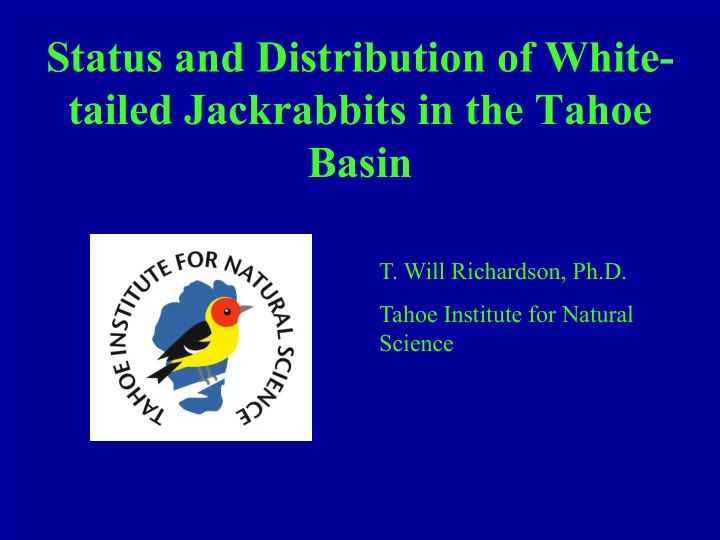

Status and Distribution of White- tailed Jackrabbits in the Tahoe Basin T. Will Richardson, Ph.D. Tahoe Institute for Natural Science
Montane Lagomorphs • Ignored by recent monitoring efforts at Tahoe and throughout Sierra • Hold keystone positions in shaping both vegetation structure and predator communities • Famously fecund
Montane Lagomorphs
Montane Lagomorphs
Montane Lagomorphs • Pika ( Ochotona princeps ) • Nuttall’s Cottontail ( Sylvilagus nuttallii) • Snowshoe Hare ( Lepus americanus tahoensis ) • Black-tailed Jackrabbit ( L. townsendii ) • White-tailed Jackrabbit ( L. californicus )
White-tailed Jackrabbits • Large, alpine jackrabbit • Prefers open habitat • Formerly widespread and common • Pop. now fragmented and apparently declining drastically • Considered extirpated from Tahoe Basin (USFS-LTBMU, NDOW) • No documented Tahoe records for decades
White-tailed Jackrabbits
White-tailed Jackrabbits • Why no records? – High elevation – Cryptic and shy – Nocturnal – Confusion with Snowshoe Hare – Nobody’s been looking • Restricted to higher elevations – “Close to or above timber line” – Mostly above 8500’ • Potentially impacted by global climate change
White-tailed Jackrabbits • Objectives – Confirm and document persistence of species in Tahoe – Document baseline distribution – Estimate population within region – Identify habitat associations • Methods – Diagnostic sign • Pellets • Tracks – Camera trapping • Trailmaster (film) • TrophyCam (digital) – Direct Observation
Specimen Record • “Tahoe City” • “Edgewood” • “3 mi, S. Mount Rose, 8500 feet” • “Woodfords • “Hope Valley, 5270 feet” • Round Mound - 1927
Sign
Sign
Sign
Sign
Sign
Sign
Sign
Black-tailed Jackrabbit!
Sign
Complications
Complications
Complications
Complications
Complications
Why Winter? • Easier to find tracks and pellets • Less cover = more concentrated animals • Less by-catch • Easier backcountry travel
Spatial and Temporal Patterns • Habitat associations conformed to expectations – subalpine and alpine slopes and flat-topped ridges • Soil type may play a role – very little evidence in sandy, decomposed granite • Dominant vegetation was consistent – Artemisia tridentata – Leptodactylon pungens* – Holodiscus sp . – Chrysothamnos sp . – Pinus albicaulis – Juniperus occidentalis
Spatial and Temporal Patterns • Greatest apparent densities associated with largest expanses of preferred habitats • Animals may move downslope in winter where it is easy to do so • Limits to dispersal • Metapopulation dynamics?
Pellet Surveys • Confident Species ID w/ DNA techniques • Easier to randomize sampling • More efficient, less dependent on cooperative weather • Population Estimates – Pellet Counts – Genetic Techniques • Connectivity of population(s)
DNA analysis of pellets
Many Thanks To: – Nevada Division of State Lands, Tahoe License Plate Grant Program – David Catalano, NDSL/NDOW – Peter Brussard, Eveline Sequin, and Dennis Murphy, UNR – Ben Sacks and Mark Statham, Veterinary Genetics Lab, UC Davis
Recommend
More recommend